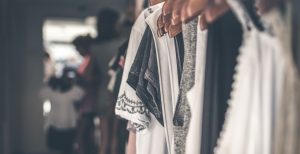Sustainability: it’s the buzzword of the fashion sector, and it’s easy to see why.
According to an article by Business Insider, the fashion industry produces 10% of all humanity’s carbon emissions, pollutes the oceans with microplastics and is the second-largest consumer of the world’s water supply.
These widely publicised, damning claims have kickstarted a revolution in the fashion industry, which is gaining momentum. While for many it’s seen as a necessary switch, in a world of fast-fashion, 9p sales and 5-minute trends, the additional costs involved are difficult for some to embrace.
Here we’ll look over some of the key factors involved in this conflict of consumer interest.

Consumers are reluctant to pay more
The very definition of ‘affordable’ has changed over the years. The 2020 downfall of Arcadia has, in part, been blamed on the rise of ‘fast fashion’ brands which can produce similar clothing at a vastly lower cost. From needing to pay workers a fair wage, to sourcing eco-friendly fabrics, there are numerous factors that mean sustainably-made clothing demands a higher price than the less-altruistic alternative… but are we willing to make the switch?
A recent international survey commissioned by Fashion Revolution found that although nearly two-thirds of those polled were concerned about environmental issues, only 13% said they’d be willing to pay more for sustainable fashion.
Things are set to change, however. Surveys have also found that 66% of global millennials are willing to spend more on brands that are sustainable – and they’re the future big spenders of the fashion sector.
Development and production costs are higher
The prices of sustainable fabrics are, on average, two and a half to four times more expensive in comparison to commonly used fabrics.
This can be seen clearly in the growth and processing of the world’s favourite fibre: cotton. Organic cotton is indisputably better for the environment, but it needs to be grown on soil that’s been cleansed for at least 3 years to allow it to return to levels of biodiversity which permit the crop to grow naturally and without toxic fertilisers. Combined with the less efficient growth, the resulting cost per kg is significantly more.
While research into recycled fabrics and plastic alternatives is ongoing, it’s clear that it’s in brands’ best financial interests to consider their own methods and weigh up the benefits of change. Recommendations from the Environmental Audit Agency last year included that ‘…the Government reforms taxation to reward fashion companies that design products with lower environmental impacts and penalise those that do not.’
Prices can be lowered by higher demand
Just look at organic food – with increased demand came higher production and lower cost. In a similar way, sustainable fashion is currently seen as a somewhat niche division of the industry – but what if that were to change?
Fashion brands cater to an audience. As soon as the audience is convinced, their buying behaviour influences other companies to follow. Brands need to consider their voice as significant in converting consumers – does their marketing communicate their strategy going forward?
New technology is here to stay
From lab-grown leather to artificial spider silk, the next generation fabrics are astoundingly futuristic. The upfront cost of developing this technology is not to be sniffed at, but the fact is that these products are now available to be utilised by companies all over the world, with the initial investment becoming less significant as usage increases.
One such technology is textile recycling, which has come a long way in recent years. Just last month Monki, a subsidiary of H&M, launched a collection created entirely through a new hydrothermal recycling process – the ‘Green Machine’ – which claims to be the first to recycle mixed cotton and polyester fibres at scale.
Reassuringly, the UK Government is creating initiatives to support the adoption of these methods, including a new tax on virgin plastics, which came into force in 2022.
So what does the future hold?
For some brands, operating sustainably and cost-effectively means removing multiple stages from the chain. Selling directly to consumers without a retailer in the traditional sense can work in theory, but for the biggest brands, this radical kind of structural overhaul just isn’t viable.
There’s a certain accountability that comes with such influence. The concept of becoming an ‘ethical’ brand may feel like an unattainable goal; but as suggested by the Environmental Audit Committee:
‘…retailers must take responsibility for the social and environmental cost of clothes. They should use their market power to demand higher environmental and labour standards from suppliers. Offering rental schemes, lifetime repair and providing the consumer with more information about the sourcing and true cost of clothing are all measures that can be more widely adopted.’
It’s clear that adopting more sustainable practices will have its own cost, but retailers must recognise that this is a necessary step in their ongoing growth and development. As demand increases, consumers will increasingly favour sustainable brands, and they’ll vote with their wallets.
Speak to our team today to see how we can help with your executive hires: +44 (0) 203 675 1459 or email Orlando Martins at [email protected].
















